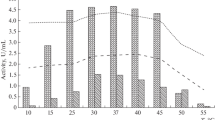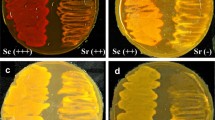Abstract
Examination of many microorganisms and soil isolates for the activity of aspartase proved thatR. rubra, G. suboxydans, A. versicolor, P. purpurogenum, E. coli, Ps. aeruginosa, A. gigantus, A. unguis, A. parasiticus and a soil isolate(S-90) had high activity of aspartase. Comparision of the activity of the aspartase by cell free extracts of these micro-organisms with the activity of the enzyme catalyzing the deamination of aspartame by the same cell free extracts showed similar kinetic characteristics. The aspartase existing in the cell free extracts seemed to catalyze the deamination of aspartame, too.
Similar content being viewed by others
Literature Cited
Ida, N. and Tokushige, M.: L-Aspartate-induced activation of aspartase.J. Biochem. 98, 35 (1985).
Bada, J.L., and Miller, S.L.: Kinetics and mechanism of the reversible nonenzymic deamination of aspartic acid.Biochemistry 7, 340 (1968).
Gawron, Q., and Fondy, T.P.: Streochemistry of the fumarase and aspartase catalyzed reactions and of the Krebs cycle from fumaric acid to d-isocitric acid.J. Am. Chem. Soc. 81, 6333 (1959).
Englard, S., Breiger H.C.: Enzymic amination and hydration of fumarate,J. Biol. Chem. 233, 1003 (1958).
Emery, T.F.: Aspartase-catalyzed synthesis of N-hydroxyaspartic acid.Biochemisty,2, 1041 (1968).
Fusee, M.C., Swann, W.E., and Calton, G.J.: Immobilization ofEscherichia coli cells containing aspartase activity with polyurethane and its application for L-aspartic acid production.Appl. Environ. Microbiol. 42, 672 (1981).
Takagi, J.S., Ida, N., Tokushige, M., Sakamoto, H., and Shimura, Y.: Cloning and nucleotide sequence of the aspartase gene ofEscherichia coli.Nucleic Acid Research,13, 2063 (1985).
Nishimura, N., and Kisumi, Mo.: Aspartase-hyperproducing mutants ofEscherichia coli.Appl. Environ. Microb. 48, 1072 (1984).
Karsten, W.E., Gates, R.B. and Viola, R.E.: Kinetic studies of L-aspartase fromEscherichia coli: Substrate activation.Biochemistry,25, 1299 (1986).
Lowry, O.H.: Protein measurement with the Folin phenol reagent.J. Biol. Chem. 193, 265 (1951).
Takagi, J.L., Fukunaga, R. Tokushige, M., and Katsuki, H.: Purification, crystallization and molecular properties of aspartase fromPseudomonas fluorescens.J. Biochem. E. 96, 545 (1984).
Author information
Authors and Affiliations
Rights and permissions
About this article
Cite this article
Chung, W., Goo, Y.M. Microbial aspartase and its activity on deamination of L-aspartyl-L-phenylalanine methyl ester. Arch. Pharm. Res. 11, 139–144 (1988). https://doi.org/10.1007/BF02857717
Received:
Issue Date:
DOI: https://doi.org/10.1007/BF02857717




